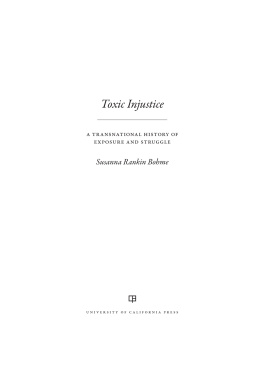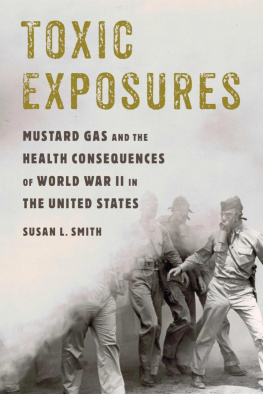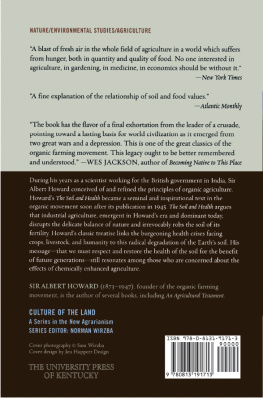ACKNOWLEDGMENTS
While the story I tell here is by turns outrageous, enraging, and hopeful, I am lucky to be able to say that my experience in writing it has been often challenging, sometimes frustrating, but usually deeply gratifying. All that has been positive in researching, writing, and revising over the years, I attribute to the many peoplefrom strangers to loved oneswho have helped and supported me along the way. Toxic Injustice began as my dissertation in the Department of American Studies at Brown University, and I was fortunate to have a committee outstanding in both intellect and generosity. Karl Jacoby, Josie Saldaa, Mari Jo Buhle, and David Egilman each provided incisive feedback and a model of rigorous scholarship. I owe David special thanks, as he has provided inspiration and support, as well as a political and practical education in the contested territory that is occupational health.
I am particularly indebted to those who provided the many documents I relied on to write this history that were not available in libraries or traditional archives. Litigation filesincluding the documents produced as evidence as well as the motions, filings, transcripts (and so on) that constitute lawsuits working partsare not easy to come by without the assistance of those involved in the process. I am grateful to a number of individuals who shared these files with me, including attorneys and others who had, in turn, received documentation from other lawyers. These include Vicent Boix, Christian Hartley, Scott Hendler, Jacinto Obregn, Carolina Quintero, Mark Sparks, and Lori Ann Thrupp. Writing about activist organizations and governmental efforts also at times posed challenges in locating primary sources. I am also grateful to Vicent Boix, Victorino Espinales, Jason Glaser, Giorgio Trucchi, and Ineke Wesseling for providing me with key documents in this vein. Without their willingness to share this documentation, much of the DBCP story would remain hidden. Thank you, Manuel ngel Esquivel and Giorgio Trucchi, for agreeing to share your moving photographs. Finally, I thank the many people in the United States, Costa Rica, and Nicaragua who spent time speaking with me about DBCP history, litigation, and pesticide policy. Although not all these interviews or more-informal conversations have been cited in the book, each has informed my understanding of this history.
This book has benefitted enormously from the careful attention paid it by reviewers and colleagues. John Soluri and an anonymous reviewer for the University of California Press each provided astute and detailed feedback that guided me in transforming this from a dissertation to a book and expanded and refined my thinking on banana production and transnational politics. I am grateful to Chris Sellers and Jo Melling for providing their example, feedback, and venues for scholarship on Dangerous Trade, and to participants in the conference of that name for the useful exchanges we had there and since. I am also grateful to Douglas Barraza, Douglas Murray, Susan Craddock, and Sarah Wald for smart feedback on ideas, conference papers, and chapters. Vicent Boix deserves another mention here, as he has been exceedingly generous with me, and our conversations and work togetheras well as his own accomplished body of journalism on the DBCP issuehave been key in shaping my understanding of this history. Thanks also to my fellow members of the Trade and Health Forum of the American Public Health Association, who throughout the years I worked with them always helped me understand the broader issues at stake.
As this project took me far from home, I am especially grateful to those men and women in Costa Rica and Nicaragua who were generous with their time, homes, memories, and knowledge. I cannot name them all here, but do want to thank a few people who went well out of their way to help me with my research, including Ineke Wesseling and many others at the Instituto Regional de Estudios en Sustancias Txicas at the Universidad Nacional, in Heredia, Costa Rica; Isabel MacDonald, Francisco Cordero, and others at the Centro de Amigos para la Paz, in San Jos, Costa Rica; Belinda Forbes and Gerardo Gutirrez in Managua, Nicaragua; and the members of the executive committee of PROSSTRAB (Promocin de la Salud de los Trabajadores), who have provided an inspiring example of a unionacademic collaboration to improve occupational health, and also assisted me in making intellectual and personal connections that I might have missed otherwise. In Costa Rica, Carlos Arguedas Mora provided me with a place to stay in Siquirres, introduced me to other unionists and DBCP-affected workers, and spent many hours talking with me about DBCP and about the current system of banana production and its ramifications on the local, national, and international scales. His death in 2010 was a sad loss for many.
Finally, thanks to Jessica Adams and Mary Sokolowski for incisive editing; Juan Quintana for careful copyediting; Judith Gallegos for transcribing a number of interviews; Maria Palmucci for help with citation management; and to Cari Lora, who started as a tutor and became a friend.
While I am indebted to all these people (and many others) for their help over the years, I of course take full responsibility for any errors or shortcomings. I anticipate that several of the people who have helped me will find points of analysis (perhaps several) that they disagree with (perhaps strongly): I would like to thank them most particularly and invite their input on issues we disagree on.
To my dearest friends and family who have sustained me over the course of this process, including those of you who have read and commented on chapters or on the entire manuscript, I am grateful for your intellectual engagement and loving support. Thank you from the bottom of my heart, Dick Adams, Charlotte Biltekoff, Winhard Bohme, Mimi Budnick, Liz Collins, Dayton Deighan, Dwyer Deighan, Hudson Deighan, Jonna Eagle, Dora Fisher, Lexi Matza, Margot Meitner, Mo Moulton, Ann Marie Nafziger, Wendy Rankin, Scout, Aliza Shapiro, Sarah Sharp, Wendy Sternberg, and Pamela Whitefield. Finally, love and thanks to Anne Griepenburg, whose insights on life and writing have immeasurably improved mine.











